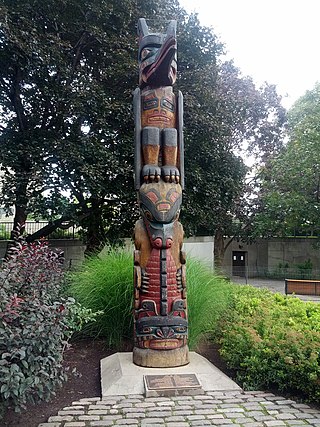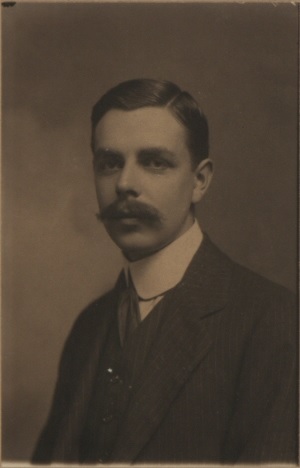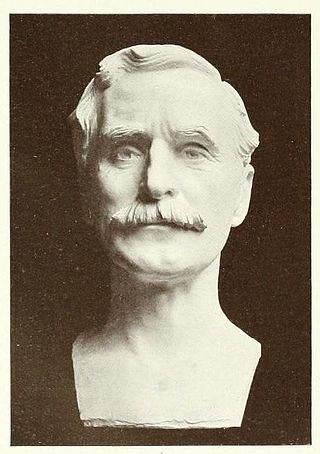
The Encyclopædia Britannica Eleventh Edition (1910–1911) is a 29-volume reference work, an edition of the Encyclopædia Britannica. It was developed during the encyclopaedia's transition from a British to an American publication. Some of its articles were written by the best-known scholars of the time. This edition of the encyclopaedia, containing 40,000 entries, has entered the public domain and is easily available on the Internet. Its use in modern scholarship and as a reliable source has been deemed problematic due to the outdated nature of some of its content. Modern scholars have deemed some articles as cultural artifacts of the 19th and early 20th centuries.

Lubaantun is a pre-Columbian ruined city of the Maya civilization in southern Belize, Central America. Lubaantun is in Belize's Toledo District, about 42 kilometres (26 mi) northwest of Punta Gorda, and approximately 3.2 kilometres (2 mi) from the village of San Pedro Columbia, at an elevation of 61 metres (200 ft) feet above mean sea level. One of the most distinguishing features of Lubaantun is the large collection of miniature ceramic objects found on site; these detailed constructs are thought to have been charmstones or ritual-accompanying accoutrements.

A totem is a spirit being, sacred object, or symbol that serves as an emblem of a group of people, such as a family, clan, lineage, or tribe, such as in the Anishinaabe clan system.

Pitt Rivers Museum is a museum displaying the archaeological and anthropological collections of the University of Oxford in England. The museum is located to the east of the Oxford University Museum of Natural History, and can only be accessed through that building.

Ralph Linton was an American anthropologist of the mid-20th century, particularly remembered for his texts The Study of Man (1936) and The Tree of Culture (1955). One of Linton's major contributions to anthropology was defining a distinction between status and role.

Earnest Albert Hooton was an American physical anthropologist known for his work on racial classification and his popular writings such as the book Up From The Ape. Hooton sat on the Committee on the Negro, a group that "focused on the anatomy of blacks and reflected the racism of the time."
George Robbins Gliddon was an English-born American Egyptologist. He worked as a United States vice-consul in Egypt and assisted Muhammad Ali Pasha's plans to modernize Egypt by attaining sugar, rice, and other mills from the United States. In 1841, he became frustrated with Pasha's destruction of archaeological sites and wrote Appeal to the Antiquaries of Europe on the Destruction of the Monuments of Egypt.
Walter Francis Willcox was an American statistician. He was born in Reading, Massachusetts, to William Henry Willcox and Anne Holmes Goodenow. He was graduated from Phillips Academy, Andover, in 1880, from Amherst College in 1884 with an A.B., and in 1888 received an A.M. degree from Amherst College. He received an LL.B degree (1887) and a Ph.D. (1891) from Columbia University. In 1906 he received an honorary LL.D. degree from Amherst College.

The Museum of Archaeology and Anthropology, also known as MAA, at the University of Cambridge houses the university's collections of local antiquities, together with archaeological and ethnographic artefacts from around the world. The museum is located on the university's Downing Site, on the corner of Downing Street and Tennis Court Road. In 2013 it reopened following a major refurbishment of the exhibition galleries, with a new public entrance directly on to Downing Street.

Ivor Hugh Norman Evans (1886–1957) was a British anthropologist, ethnographer and archaeologist who spent most of his working life in peninsular British Malaya and in North Borneo.
Negroid is an obsolete racial grouping of various people indigenous to Africa south of the area which stretched from the southern Sahara desert in the west to the African Great Lakes in the southeast, but also to isolated parts of South and Southeast Asia (Negritos). The term is derived from now-disproven conceptions of race as a biological category.
Pusilhá is an archaeological site in Belize. The location of this Late Classic Maya urban complex, along the east and west flow of trade, made the city a major transfer point for economic activities in the whole region. In addition, the city gave archaeologists a historical view of a secondary Maya site. Large and extended excavation efforts have changed the overall picture of Maya social and political relationships between larger and smaller cities and challenged the prevailing view of conquest and absorption of smaller cities into the larger cities in the region. The research conducted at Pusilhá began in 1927 and continues to this day.

Playa de los Muertos is an archaeological site from the Middle Formative period and is located on the Honduras north coast, in the Ulua valley, however it has "had a continuous history going back as early as any sedentary society yet documented in Mesoamerica". Thought to at one time have been a village, Playa de los Muertos is primarily known through its burials and ceramics. Archaeologists have identified a strong Aztec and Mayan influence on the early inhabitants at Playa de los Muertos, however it is considered a distinct culture. The site is most notable for its finely made ceramic figurines, famously excavated by Dorothy Popenoe. These figurines, in particular those depicting the female form, have helped archaeologists interpret gender roles at the site. Archaeologists believe that people at Playa de los Muertos likely participated in long-distance trade networks which reach from Guatemala to the Gulf Coast Olmec centers.
La Ciudad Blanca is a legendary settlement said to be located in the Mosquitia region of the Gracias a Dios Department in eastern Honduras. It is also known by the Pech name Kahã Kamasa. This extensive area of rainforest, which includes the Río Plátano Biosphere Reserve, has long been the subject of multidisciplinary research. Archaeologists refer to it as being a part of the Isthmo-Colombian Area of the Americas, one in which the predominant indigenous languages have included those in the Chibchan and Misumalpan families. Due to the many variants of the story in the region, most professional archaeologists doubt that it refers to any one actual settlement, much less one representing a city of the Pre-Columbian era. They point out that there are multiple large archaeological sites in the region and that references to the legendary White City cannot be proven to refer to any single place.
George Byron Gordon (1870–1927) was a Canadian-American archaeologist, who graduated from Harvard University in 1894. While studying at Harvard, he participated in excavations at Copan in Honduras under the direction of John G. Owens in 1891. Following Owens’ death in the field, Gordon took command of the Copan expeditions from 1894 to 1895 and in 1900–1901. After his time in Honduras, George Byron Gordon was hired by the University of Pennsylvania where he led two expeditions to Alaska in 1905 and 1907. He spent the remainder of his twenty-four year employment at the University of Pennsylvania collecting antiquities for the University of Pennsylvania Museum of Archaeology and Anthropology’s North American collections, and he remains one of the museum's largest contributors of North American artifacts.

Sir Charles Hercules Read was a British archaeologist and curator who became Keeper of British and Mediaeval Antiquities and Ethnography at the British Museum, and President of the Society of Antiquaries of London, following his mentor Augustus Wollaston Franks in the first position in 1896, and in the second from 1908 to 1914 and again from 1919 to 1924, after being Secretary since 1892. He began periods as President of the Royal Anthropological Institute of Great Britain and Ireland in 1899 and 1917. He was knighted in 1912 and retired from the British Museum in 1921. He usually dropped the "Charles" in his name, especially after he was knighted, though not consistently. "A man of handsome and even striking appearance", he was a major figure in British museum curation in his day, though he published relatively little.
John G. Owens was an American archaeologist who specialized in Mayan culture, and who also published ethnological studies on the Pueblo Indians of the American Southwest.

Charles Pickering Bowditch was an American financier, archaeologist, cryptographer and linguistics scholar who specialized in Mayan epigraphy.

Emil Torday, was a Hungarian anthropologist. He was the father of the romance novelist Ursula Torday.
The Middle American Research Institute was established at Tulane University in 1924.












